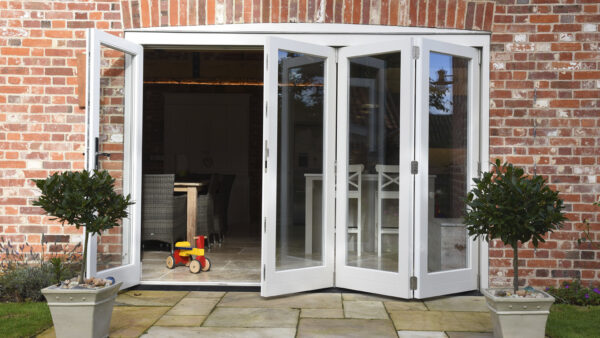Kirk Smith of Allegion UK discusses fire door neglect and how to spot the potential faults that could be compromising your fire safety procedures.

Purpose built to compartmentalise fire and smoke, fire doors are recognised as a critical element of passive fire protection and exist in practically every building where we work, sleep and live. Such is their importance; they are acknowledged by several professional bodies and are a legal requirement in non-domestic premises and houses in multiple occupation (HMOs).
Day to day we use them without a thought, yet fire doors consist of much more than a simple piece of furniture. A fire door is a complete door assembly, comprising of a doorset fit with a door frame, leaf, essential hardware, edge seals and integral panels. In the event of a fire, not one of these elements can fail, and so to meet the necessary standards, a fire doorset must pass one or more of a series of standardised tests, confirming its certification and FD ratings.

So why can fire doors experience failure in critical moments? Between neglect, misspecification and a misunderstanding of their significance, 75% of fire doors fail to meet the required standard, as has been revealed by the Fire Door Inspection Scheme (FDIS). To combat this, a conscious effort is needed, with more attention given to fire doors and their components. Once installed, simple checks can help ensure a fire door is safe to fulfil its role, but where should you start when spotting a door’s potential faults?
Fault checks
Upon operation, a fire door calls upon its many elements – all of which must function in tandem to ensure the door is effective in a fire situation. Generally, there are eight core areas to consider when conducting regular risk assessments and spotting potential faults. Kirk Smith of Allegion UK explains more:
Door Furniture
“When opening or closing a door, our hands instinctively reach out for the handle. Should it be absent, or even loose, it could affect whether a door can be opened in an emergency. Because of this, a handle should always remain installed on a fire door and its screws tight. Bolt-through fixings pass right through the door and the lock or latch case and will strengthen the installation of handles by preventing the screws from moving or becoming loose. Check whether the handle operates smoothly and returns freely to a horizontal position after use, too. Finally, if the fire door in question is on an escape route, it must open in the direction of travel, without the use of a key. Keep it simple, but effective.”
Hinges
“Hinges are a necessary pivot action fixing that provides the movement to a door. A standard height fire door requires the installation of three hinges minimum, with intumescent pads fitted. A door standing over 2.2 metres will require four hinges. This will prevent the door from warping in a fire due to its weight, and so should you see a fire door only hung on two hinges, it must be changed. Again, screws must be fitted securely, and the hinges themselves must be free of metal fragments and oil leakage as this could indicate signs of wear. When it comes to certification, check for CE or BS EN 1935 marks. Hinges may be hidden somewhat, but they can never be overlooked.”
Locks and Latches
"To form an effective barrier against fire, a fire door must close fully. Locks and latches help to keep doors held shut and so must be fixed firmly and working correctly. Upon inspection, it’s important to check whether the latch engages fully into the strike plate and whether the door can be held firmly in place without rattling. Failure to do so may indicate faulty or damaged hardware. Like hinges, check for metal dust deposits – typically located on the latch bolt or strike plate – as this could also show wear or damage.”

Door Closers
“Door closers facilitate the operation of a fire door and must be UKCA and CE marked and tested to EN 1154. When opened, a fire door should fully engage into the door frame every time, shutting tight by use of its own self-closing device. When conducting checks, the trick is to open a door to 5° or 75mm, and upon letting it go, it should close and engage the latch successfully. Failing to do so could indicate the door closer has been incorrectly installed or damaged and, therefore, needs adjustments or replacing. Adjustments can be made to the closing power and speed of door closers, and in busy environments such as schools and hospitals, a prolonged closing action is useful, giving people extra time to pass through the doorway.”
Hold Open Devices
“Buildings with high footfall may benefit from approved, electromagnetic hold-open devices tested to BS EN 1155, which permit open fire doors that automatically release to close in the event of a fire. Naturally, these systems are more complex and regular maintenance is mandatory, so it’s vital to spot any potential faults, such as the door straining against its self-closing device upon operation. Should an electromagnetic hold-open device not release the door when a fire alarm is activated, a problem has occurred and must be resolved immediately.”
Exit Devices
“Exit devices are designed to provide safe and effective escape through a doorway with minimum effort. All panic and emergency exit devices must be functioning correctly, with fixings on the operating device, bolts and strikes tightly fit. Emergency exit devices and panic exit devices should be tested to BS EN 179 and BS EN 1125 respectively, as well as UKCA and CE marked. Aside from their mechanical operation, it’s critical to keep emergency exits clear and without obstruction – assisting a quick escape when called upon.”
Door Seals
“When rated FD30 or FD60, a fire door is certified to resist smoke and fire for 30 or 60 minutes, respectively. For this to remain true, a doorset must be fitted with intumescent seals which, in the event of a fire, expand significantly to close the gap between the door and its frame. Intumescent seals should track continuously around the frame or door leaf and must remain in good condition, intact and undamaged. If you can see excessive gaps between the side of the door and the frame, a fire door may be ineffective. A maximum gap of 3mm is recommended around all fire doors and can be assessed with simple gap tester tools.”
Signage
“Although not a mechanical element of a fire door, signage plays an important role in fire door safety and must be considered when checking for faults. Providing quick and key information in an emergency, ‘Fire Door Keep Shut’ signage must be fitted to both sides of a fire door. Additionally, ‘Automatic Fire Door Keep Clear’ signs must appear on fire doors with hold open devices and ‘Fire Door Keep Locked’ signs must be fitted to doors without self-closing devices – which can commonly be found in storerooms and cupboards.”
A complete and functional fire door is a prerequisite for fire safety and regular maintenance periods are required to ensure they retain their standard while in operation. The first step is to understand the various components of a fire doorset and the potential faults to look out for when evaluating its condition. Should any doubt linger, it’s crucial to seek out professional advice immediately. Checks can save lives but where action is an obligation, knowing what to look out for is only half of the responsibility.








